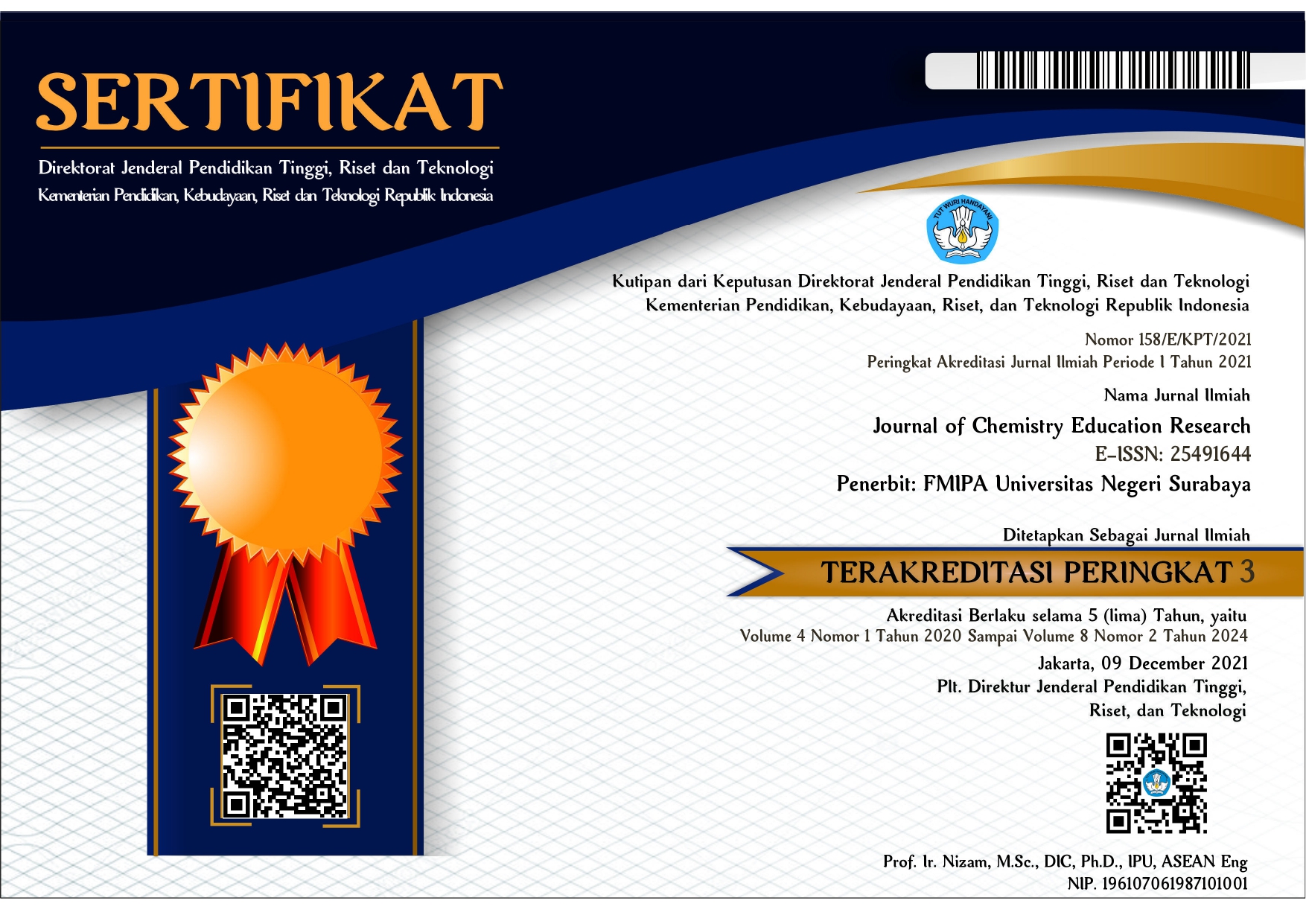THE EFFECTIVENESS OF USING 3D SIMULATION MEDIA IN ONLINE LEARNING OF MOLECULAR GEOMETRY ON IMPROVING LEARNING
DOI:
https://doi.org/10.26740/jcer.v6n1.p19-25Keywords:
3D simulation media, Online learning, Molecular Geometry, Learning outcomesAbstract
Abstract
Molecular geometry is one of the materials in chemical bonds that are abstract. Where students must think imaginatively in predicting the three-dimensional shape of an existing molecule. But because it is abstract the majority of students have difficulty understanding and visualizing the theory of molecular form. This problem is coupled with online learning that makes it difficult for teachers to convey molecular geometry materials. The solution to the problem is the use of interactive learning media for PhET 3D simulation. This study aims to determine the effectiveness of the use of 3D simulation media in online learning of molecular geometry materials. This research is an experimental research in the form of pre- experimentation with the design of one group pretest posttest. Data collection techniques are carried out with tests and questionnaires. Sampling is done by purposive sampling. The result of N-Gain data analysis of experiment class 0.79 with percentage of N-Gain score of 79.8 % with high criteria. This shows that the use of 3D simulation media in online learning of molecular geometry molecular shapes is very effectively used in the teaching and learning process. Hypothesis testing is carried out t-paired with a level of trust of 5%. Interpretation of hypothesis testing by looking at the value of Sig (2 tailed) of 0.00 where 0.00 < 0.05. it can be concluded that there are significant differences in the use of 3D simulation media. Based on effect size test the value obtained is 0.98 with high criteria. These results can be interpreted that the use of 3D simulation media in molecular geometry learning has a scale of effect or strong influence on student learning outcomes. The result of student response data analysis there are four aspects, namely, aspects of students' interest in following learning, material understanding, ease of problem solving, and group cooperation. Aspects of students' interest in following learning and material understanding aspects have excellent criteria. As for the aspect of ease of problem solving and group cooperation has good criteria.
Keyword: 3D simulation media, Online learning, Molecular Geometry, Learning outcomes
References
Mansyur, A. (2020). Dampak COVID-19 Terhadap Dinamika Pembelajaran di Indonesia. Education and Learning Journal, 1(2), 113.
Solfarina. (2012). Peningkatan Pemahaman Konsep Ikatan Kimia Mahasiswa Calon Guru Melalui Pembelajaran Berbasis E-Learning. Jurnal Chemical, 13(2), 4.
Rusman. (2012). Belajar dan Pembelajaran Berbasis Komputer. Bandung: Alfabeta.
Atmawinaldi, R., Harun, A.I., & Sartika, R. P. (2019). PENGARUH MEDIA PHYSIC EDUCATIONAL TECNOLOGY (PhET) TERHADAP HASIL BELAJAR SISWA PADA MATERI BENTUK MOLEKUL. Jurnal Pendidikan Dan Pembelajaran.
Sugiyono. (2013). Metode Penelitian Pendidikan Pendekatan Kuantitatif, Kualitatif, dan R&D. Bandung: Alfabeta.
Dewita, N. (2020). Pengaruh Media Pembelajaran Berbasis Visualisasi 3d Dan Animasi Molekul Terhadap Hasil Belajar Siswa Sma Pada Sub Pokok Bahasan Bentuk Molekul. Universitas Negeri Medan.
Suprijono, A. (2010). Cooperative Learning Teori dan Aplikasi PAIKEM. Yogyakarrta: Pustaka Pelajar.
Sutrisno, Poedjiastoeti, S., & Sanjay, I. (2017). Efektivitas Pembelajaran Bentuk Molekul Dengan Pemodelan Real Berbasis Penemuan Terbimbing Untuk Melatihkan Keterampilan Berpikir Tingkat Tinggi Siswa. Jurnal Penelitian Pendidikan Sains.
Downloads
Published
Issue
Section
License
Copyright (c) 2022 JCER (Journal of Chemistry Education Research)

This work is licensed under a Creative Commons Attribution-NonCommercial 4.0 International License.
 Abstract views: 467
,
Abstract views: 467
, PDF Downloads: 560
PDF Downloads: 560



